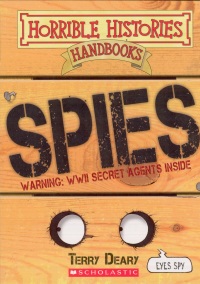| ________________
CM . . .
. Volume XVII Number 6. . . .October 8, 2010 
 |
Spies. (Horrible Histories Handbooks).
Terry Deary. Illustrated by Mike Phillips.
Toronto, ON: Scholastic Canada, 2009.
96 pp., pbk., $7.99.
ISBN 978-1-4431-0241-4.
Subject Headings:
Spies-Juvenile literature.
World War, 1939-1945-Secret service-Juvenile literature.
Grades 4-7 / Ages 9-12.
Review by Daphne Hamilton-Nagorsen.
*** /4
|
| |
|

excerpt:
Spies who wanted to take pictures of foreign buildings often pretended to be on holiday. They stood a friend in front of their camera but were really taking a picture of the building behind their friend. (Because the person in the picture was often someone's relative, these pictures became known as "Aunt Minnies.")
One British spy was cycling alone in Austria before the Second World War. He made friends with the guards at a secret army camp. He asked the guards if he could have their pictures to take home and they posed for him while he took photographs of the defences behind them!
Spies is a humorous look at spies during the Second World War. As with all "Horrible Histories Handbooks," the primary focus in on British "history," in this case spies, especially the Special Operations Executive (SOE). While a few spies for other countries (primarily Germany) are covered, the focus on British spies keeps the topic manageable for the size of the book.
Spies, like all "Horrible Histories Handbooks," is intended as recreational reading. There is a broad variety of factual information covered, ranging from how mines were disguised to how agents were disguised, along with a brief timeline of World War II. However, the information provided is limited to a broader overview rather than an in-depth look at spies in the Second World War. The short page length and plentiful cartoons limit the amount of information covered while allowing for much humour which fulfills the primary purpose of any "Horrible Histories" book—to make history fun and appealing.
Spies contains many colour illustrations which are primarily part of the text rather than an embellishment of the text. In many cases, the text and illustrations combine to read more like a comic strip than a book, a quite effective approach for the information being covered. This technique not only makes the information more accessible, but it also will help Spies appeal to a wider audience.
"Horrible Histories Handbooks" are always history with "all the nasty bits," but Deary keeps everything very age-appropriate. This is partly accomplished through the illustrations and the use of humour. In addition, the small amount of time spent on each topic helps to limit the material to what is age-appropriate.
Spies is a well-presented, fun look at British spies in the Second World War, and it is a book that readers of the "Horrible Histories Handbooks," along with many others, will enjoy.
Recommended.
Daphne Hamilton-Nagorsen is a graduate of the School of Library, Archival and Information Studies at the University of British Columbia, Vancouver, BC.

To comment
on this title or this review, send mail to cm@umanitoba.ca.
Copyright © the Manitoba Library Association. Reproduction for personal
use is permitted only if this copyright notice is maintained. Any
other reproduction is prohibited without permission.
NEXT REVIEW |
TABLE OF CONTENTS FOR THIS ISSUE
- October 8, 2010.
AUTHORS |
TITLES |
MEDIA REVIEWS |
PROFILES |
BACK ISSUES |
SEARCH |
CMARCHIVE |
HOME |
